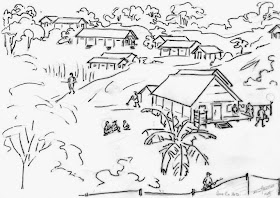Meet Maribel (not her real name), from the Philippines. The first time I met her was during my story writing class. She sat in a corner, quiet between chatting classmates, hunched over her papers. On all the questions of my writing exercise she gave the same answer. The first thing she saw when she woke up in her bunk bed at the shelter? She wouldn’t know, she only felt sadness for missing her son. What breakfast looked and tasted like? She wouldn’t know, she only felt sadness for missing her son. Her most and least favourite activity? She wouldn’t know, she only felt sadness for missing her son.
Not sure how to cheer her up, I gave Maribel a clean sheet and said: ‘Ok. Then write about your son for me.’
Not much later Maribel had filled the entire page with stories about how she picked the eight-year-old boy up from school, and took him to the market. They would indulge in their favourite fruit: mango. Maribel told about all his favourite foods she would cook for him, which were her favourites too, and the games they would play. Impressed, I told her how great her writing was. ‘You just showed me how much you care about your son, without once using the word love.’
The week after, Maribel joined the ‘Dreams’ class, where girls are encouraged to think about their future in a positive way. Whilst looking at the future, I learned more about Maribel’s history. She came from a very poor family, but had married a man whose parents were the owners of a mango farm, and quite affluent. Maribel’s in-laws had always looked down on their peasant daughter-in-law, straining the relationship with her husband. The light of her life was her son, and she focussed all her love on him. Her dream was to plant a mango tree, together with her son, in her own garden. This class, Maribel was much less shy, and smiled regularly.
Another week and another writing class later we met again in the Dreams class. During the introductions I marvelled at how Maribel had changed. She was now always the first to answer any question, stimulating others to join as well. The exercise of the day was to name a person you admired. It could be a famous person, a neighbour, or someone in the family. It should be someone you would like to be, if only for a day. Maribel was the first to write the name of who she wanted to be on her paper, and showed it proudly to the others. She had named Cinderella. The other girls nodded approvingly. But Maribel was not looking to be rescued by Prince Charming.
Maribel told us how her life had been like that of Cinderella. Her own mother had died young, and her rich in-laws had never treated her much better than they would a servant. She wished for the strength of Cinderella, because Cinderella never lost hope. Cinderella found love and happiness in small things. And she always stayed friendly and kind, despite her hardships. Maribel hoped she could be just like that.
Maribel is still staying in the HOME shelter, waiting for the Ministry of Manpower to solve her case, so she can go home and plant that mango tree with her son. Maribel is not waiting for Prince Charming. She will make her own happy end.





